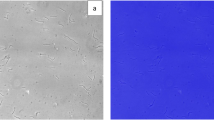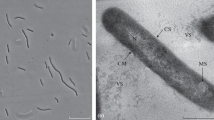Abstract
The first psychrophilic obligate methanotroph was isolated from the tundra soil in the Polar Ural. The organism has an optimal temperature range of 3.5°–10°C, but at 20°C the growth is minimal. The cells of the metanotroph are Gram-negative cocci resemblingMethylococcus in appearance but of low G+C content (G+C=45.6 mol%). Membranes are arranged into bundles of vesicular discs. Gas vesicles are formed at the temperature range of 7°–20°C, and the number of cells with vesicles increases with the temperature. Only methane or methanol serves as substrate for growth in the mineral salt medium. Psychrophilic methanotrophs might be important components of a microbial gas filter in the tundra region.
Similar content being viewed by others
Literature Cited
Bowman JP, Sly LI, Hayward AC (1981) Contribution of genome characteristics to assessment of taxonomy of obligate methanotrophs. IJSB 4:301–305
De Ley J, Cattoir H, Reynaets A (1970) The quantitative measurement of DNA hybridization from renaturation rates. Eur J Biochem 12:133–142
Galchenko VF, Andreev LV, Trotsenko YA (1986) Taxonomy and identification of obligate methanotrophic bacteria. Puschino, AN SSSR Publ
Marmur JA (1961) A procedure for isolation of deoxyribonucleic acid from microorganisms. J Mol Biol 3:208–218
Namsaraev BB, Zavarzin GA (1972) Trophic links in the culture oxidizing methane. Microbiologic T XLI 6:999–1006
Omelchenko MV, Savelyeva ND, Vasilyeva LV, Zavarzin GA (1992) A psychrophilic methanotrophic community from tundra soil. Microbiologia T 61 6:1072–1077 (Russian)
Omelchenko MV, Vasilyeva LV, Khmelenina BN, Trotsenko YA (1993) Pathways of primary and intermediary metabolism of the psychrophilic methanotrophic microorganism. Microbiologia T 62 5 (in press)
Owen RJ, Legros RM, Lapage SP (1978) Base composition, size and sequence similarities of genome deoxyribonucleic acids from clinical isolates ofPseudomonas putrefacies. J Gen Microbiol 104:127–138
Romanovskaya VA, Stolyar SM, Malashenko YR (1991) Systematics of methylotrophic bacteria. Kiev: “Naukova Dumka” Publ.
Ruter A, Kellenberger E, Birch-Andersen A, Maale O (1958) Etude en microscope electronique de plasmas contenant de l'acide desoxyribonucleique les nucleoides des bacteries en croissance active. Z Naturforsch B 13:597
Sebacher DI, Harriss RC, Bartlett KB, Sebacher SM, Grice SS (1986) Atmosphere methane sources: Alascan tundra bogs, an alpine fen, and a subarctic boreal marsh. Tellus 38(B):1–10
Slobodkin AI, Panikov NS, Zavarzin GA (1992) Microbiological methane production and consumption in the tundra and middle taiga bogs. Microbiologia T 61 4:683–691 (Russian)
Svensson BH, Rosswall T (1984) In situ methane production from acid peat in plant communities with different moisture regimes in a subarctic mire. Oikos 43:341–350
Vecherskaya MS, Galchenko VF, Sokolova EN, Samarkin VA (1993) Activity and species composition of aerobic methanotrophic communities in tundra soils. Curr Microbiol 27 (in press)
Whalen SC, Reeburgh WS, Kizer KS (1991) Methane consumption and emission by taiga. Glob Biogeochem Cycl 5 3:261–273
Whittenbury R, Dalton H (1980) The methylotrophic bacteria. In: Starr MP, Stolp H, Truper HG (eds) The prokaryotes, New York: Springer-Verlag, pp 894–902
Whittenbury R, Phillips K, Wilkinson I (1970) Enrichment, isolation and some properties of methane-utilizing bacteria. J Gen Microbiol 61:205–218
Zavarzin GA, Kotsyurbenko OR, Soloviova TI, Nozhevnikova AN (1993) The temperature threshold in the development of methanogenic versus acetogenic community from the tundra soil. Dokladi Academii Nauk SSSR 6:792–794
Zhilina TN, Zavarzin GA (1991) Methane production at the low temperature by the pure culture of methanosarcina. Dokladi Academii Nauk SSSR 5:1242–1245
Author information
Authors and Affiliations
Rights and permissions
About this article
Cite this article
Omelchenko, M.V., Vasilyeva, L.V. & Zavarzin, G.A. Psychrophilic methanotroph from tundra soil. Current Microbiology 27, 255–259 (1993). https://doi.org/10.1007/BF01575988
Issue Date:
DOI: https://doi.org/10.1007/BF01575988




